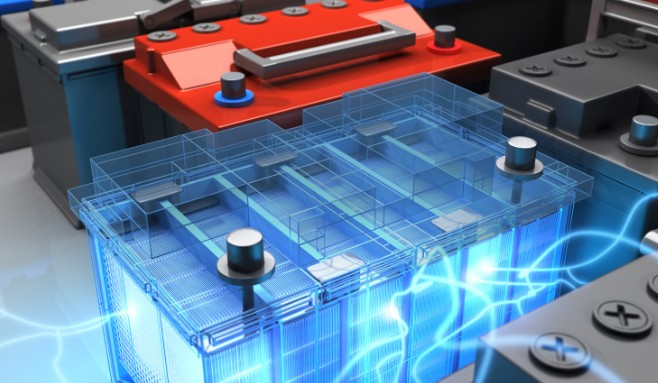As interest in renewable energy grows, more homeowners in North Wingfield are investing in solar panels and solar PV systems in particular.
If you're not familiar with PV systems, it stands for photovoltaic as special cells in the panels convert light particles from the sun (photons) into usable electricity (volts). This is different from the older style of solar panels that only heat water (known as solar thermal panels).
At Skylamp Solar, we know all there is to know about solar panels of all types, so if you want to learn more about solar battery storage installation in North Wingfield for PV systems, we have all the information you need.

Installing a solar battery system is one of the best ways to maximise the return on your investment long-term.
Here's how it will benefit you:
If sustainable living is a priority for you, a solar battery storage system will boost your efforts considerably.
Your battery will store electricity during daylight hours for use at night when the solar panels are inactive. You won't need to use electricity from an energy supplier, leading to significantly lower electricity bills.
You can actually earn money by selling excess energy back to the national grid under the smart export guarantee (SEG)! Anything you don't use would otherwise be wasted without solar panel battery storage.
With careful management, you can eventually end your reliance on your energy supplier. You can have complete energy independence.
There are currently two types of battery storage available: lead-acid solar batteries and lithium-ion solar batteries.
The first one uses traditional battery technology while lithium-ion technology is relatively new. On the whole, the newer type is far superior in terms of efficiency and lifespan (see below) and they have a futuristic design that makes them more appealing than their older counterparts.
They're also smaller and lighter, ideal for indoor installations.
As you'd guess, this makes them a more expensive option, but it's worth investing in these if you can.
Even so, the lead-acid type is reliable and does the job perfectly.


One big question that people ask is, what size solar battery do I need? Essentially, you need to know the size of the battery and how many. The answer depends on how much energy you use on average, whether you are on-grid or off-grid, and the size of your solar system.
This can be a complex issue and it's easy to get bogged down in details, so here's a simplified explanation:
The average UK home uses between 8-10 kWh of electricity every day. At the smaller end, solar panel battery storage is between 2.5 kWh and 5 kWh. And at the upper end, you're looking at 13-15 kWh.
The problem is that solar panels generate electricity during the day when energy use is generally lower. You need to make sure that your battery storage has enough solar electricity to last through the night.
It's likely that you'll need help figuring this all out, and the team at Skylamp Solar is only too pleased to guide you in the right direction.

It depends on several factors, including:
This gives us quite a broad price range, running from £1,000 to £6,000.
Again, Skylamp Solar in North Wingfield can help you to find the right battery storage products to suit your requirements and your budget.


In most cases, yes. The Skylamp Solar team can usually retrofit a solar battery without too much fuss.
The vast majority of existing solar PV systems in the North Wingfield are compatible with battery storage products. If you happen to have a system that wasn't designed to include battery storage, you will need to replace the inverter or have an AC-coupled battery installed.
The short answer is, anywhere you like!
Basically, it's up to you. Some property owners in North Wingfield like to show off their solar batteries, especially the sleek, futuristic-looking lithium-ion batteries. Alternatively, you can hide them away in a loft, utility room, garage or cupboard.
However, there are several considerations as to the positioning of your battery storage:

If the space is too restricted it will make installation more difficult. The fitter needs to be able to work comfortably and safely within the area. This will also apply to future maintenance work.
If you want to add further solar battery storage at a later date, you should make sure that there is plenty of room next to your existing battery.
Ideally, it's preferable to situate battery systems as close to the inverter and charge controller as possible. In fact, the whole solar system works better when the cables connecting them are kept as short as possible. Shorter cables mean better efficiency!
You also need to think about the safety aspects concerning the positioning of your solar battery storage, such as:
If your inverter is here, it makes sense to consider putting the battery system nearby. After all, it's close to the other equipment including your solar PV panels.
However, it depends on the temperature there during the hottest and coldest months. If your loft is well-insulated then this may be a viable option. Also, you can insulate the battery, as mentioned above.
The real issue relates to the weight of lead-acid batteries, as some of these can weigh 90kg. If you need several of these for storing electricity from your solar panels, this adds a lot of extra strain on your roof structure.
You can, as long as all of the above issues are taken into consideration!
Once you have considered all of these points, you are ready to take solar battery installation to the next stage.

On average, it only takes a few hours to fit solar batteries and connect them to your solar PV system. If this is included when you install solar panels it shouldn't add too much time to the overall job. And when retro-fitted to an existing solar panel system it only takes between two and four hours at the most.
The most difficult part is the wiring, and our team will always take great care to ensure that this is completed accurately.
It is possible for almost anyone to fit their own solar panel system, including a solar battery, if they are confident they can do so safely, they are fit and healthy, and have at least a rudimentary knowledge of the subject.
However, few people would achieve the same end results as professional installers, like Skylamp Solar. The fact is that our team has been trained and is experienced in all aspects of fitting solar panels. The training is ongoing, due to the ever-improving technology. It's not so much that you'd do a bad job, simply that we do this every day!
Also, there's the safety aspect to consider: fitting a battery to an electrical system requires great care, knowledge and focus. If you get the wiring wrong, you are risking your home and the lives of you and your family.


The average lifespan of a lead-acid solar battery is between 5 and 7.5 years and 11 to 15 years for lithium-ion batteries. This means that you'll be expected to replace them sometime during the lifespan of your solar PV panels (these last between 25 and 40 years).
Currently, the majority of people with photovoltaic panels use a lead-acid battery system. This is mostly because they are cheaper, but the price of lithium-ion batteries is gradually becoming more affordable (with a 65% decrease in the last decade).
Although they're more expensive, lithium-ion solar batteries are the most cost-effective choice in the long term. They are lighter, more compact, highly efficient, and aesthetically pleasing.
Whether you have solar panels installed or you're considering it, adding a solar battery storage system is a big decision.
Investing in renewable energy is in everyone's best interest, and is a great way to save money, especially at a time when electricity prices in North Wingfield are rising alarmingly. Solar power, and photovoltaic systems in particular, is one of the most popular methods right now, but it can be a confusing and daunting task finding the right supplier and a professional team of installers in North Wingfield that you can trust.
Skylamp Solar will be with you from start to finish, offering expert advice on solar panel systems and solar battery storage. We will help you to make the most of your investment, save money through efficient clean energy storage, and to drastically reduce your energy bills.
Call us today and start your solar energy journey to a cheaper, greener future.

The average lifespan of a lead-acid solar battery is between 5 and 7.5 years and 11 to 15 years for lithium-ion batteries. This means that you'll be expected to replace them sometime during the lifespan of your solar PV panels (these last between 25 and 40 years).
On average, it only takes a few hours to fit solar batteries and connect them to your solar PV system. If this is included when you install solar panels it shouldn't add too much time to the overall job. And when retro-fitted to an existing solar panel system it only takes between two and four hours at the most.
If your inverter is here, it makes sense to consider putting the battery system nearby. After all, it's close to the other equipment including your solar PV panels.
In most cases, yes. The Skylamp Solar team can usually retrofit a solar battery without too much fuss.